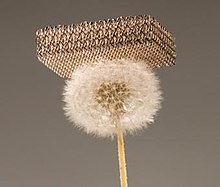|
Metallic microlattice A metallic microlattice is a synthetic porous metallic material consisting of an ultra-light metal foam. With a density as low as 0.99 mg/cm3 (0.00561 lb/ft3), it is one of the lightest structural materials known to science.[1] It was developed by a team of scientists from California-based HRL Laboratories, in collaboration with researchers at University of California, Irvine and Caltech, and was first announced in November 2011. The prototype samples were made from a nickel-phosphorus alloy.[2] In 2012, the microlattice prototype was declared one of 10 World-Changing Innovations by Popular Mechanics.[3] Metallic microlattice technology has numerous potential applications in automotive and aeronautical engineering.[4] A detailed comparative review study among other types of metallic lattice structures showed them to be beneficial for light-weighting purposes but expensive to manufacture.[5] SynthesisTo produce their metallic microlattice, the HRL/UCI/Caltech team first prepared a polymer template using a technique based on self-propagating waveguide formation,[6][7] though it was noted that other methods can be used to fabricate the template.[8] The process passed UV light through a perforated mask into a reservoir of UV-curable resin. Fiber-optic-like "self-trapping" of the light occurred as the resin cured under each hole in the mask, forming a thin polymer fiber along the path of the light. By using multiple light beams, multiple fibers could then interconnect to form a lattice. The process was similar to photolithography in that it used a two-dimensional mask to define the starting template structure, but differed in the rate of formation: where stereolithography might take hours to make a full structure, the self-forming waveguide process allowed templates to be formed in 10–100 seconds. In this way, the process enables large free-standing 3D lattice materials to be formed quickly and scalably. The template was then coated with a thin layer of metal by electroless nickel plating, and the template is etched away, leaving a free-standing, periodic porous metallic structure. Nickel was used as the microlattice metal in the original report. Owing to the electrodeposition process, 7% of the material consisted of dissolved phosphorus atoms, and it contained no precipitates.[8] PropertiesA metallic microlattice is composed of a network of interconnecting hollow struts. In the least-dense microlattice sample reported, each strut is about 100 micrometres in diameter, with a wall 100 nanometres thick. The completed structure is about 99.99% air by volume,[2] and by convention, the mass of air is excluded when the microlattice density is calculated.[8] Allowing for the mass of the interstitial air, the true density of the structure is approximately 2.1 mg/cm3 (2.1 kg/m3), which is only about 1.76 times the density of air itself at 25 °C. The material is described as being 100 times lighter than Styrofoam.[9] Microlattices can also be 100 times stronger than regular polymers.[10] Metallic microlattices are characterized by very low densities, with the 2011 record of 0.9 mg/cm3 being among the lowest values of any known solid. The previous record of 1.0 mg/cm3 was held by silica aerogels, and aerographite is claimed to have a density of 0.2 mg/cm3.[11] Mechanically, these microlattices are behaviorally similar to elastomers and almost completely recover their shape after significant compression.[12] This gives them a significant advantage over earlier aerogels, which are brittle, glass-like substances. This elastomeric property in metallic microlattices furthermore results in efficient shock absorption. Their Young's modulus E exhibits different scaling, with the density ρ, E ~ ρ2, compared to E ~ ρ3 in aerogels and carbon nanotube foams.[8] ApplicationsMetallic microlattice may find potential applications in thermal and vibration insulators such as shock absorbers, and may also prove useful as battery electrodes and catalyst supports.[8] Additionally, the microlattices' ability to return to their original state after being compressed may make them suitable for use in spring-like energy storage devices.[2] Automotive and aeronautical manufacturers[which?] are using microlattice technology to develop extremely lightweight and efficient structures that combine multiple functions, such as structural reinforcement and heat transfer, into single components for high-performance vehicles.[4] Similar materialsA similar but denser material, consisting of an electrodeposited nanocrystalline nickel layer over a polymeric rapid-prototyped truss, was created by researchers at the University of Toronto in 2008.[13] In 2012, German researchers created a carbon foam known as aerographite, with an even lower density than a metallic microlattice.[14] In 2013, Chinese scientists developed a carbon-based aerogel which was claimed to be lighter still.[1] Nanolattices like tube-based nanostructures are similar structures on a smaller scale. References
External links |